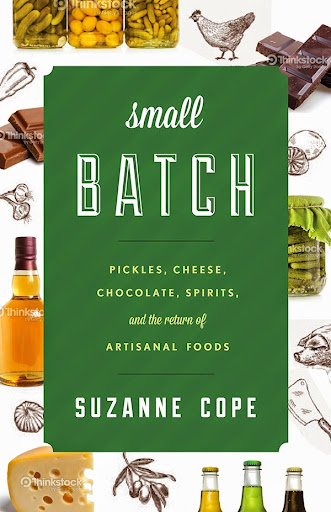One of the pure joys of travel is the food. Yes, that's right - food is a window to culture. Think about it - from the night markets of Southeast Asia to the traditional recipes of, well, any culture, what people make and eat is a product of terroir, seasons, climate, history, and more. One of my favorite books about the food of France is The Whole Fromage, which takes readers on a trail of the most interesting kind - that of cheese. What I loved about that book was the interest in small cheese producers, and how they work.
Well, I've got a great new book to share with you today that follows along that same vein of small food producers, culture, terroir, and more. Small Batch: Pickles, Cheese, Chocolate, Spirits and the Return of Artisanal Food is written by Suzanne Cope, and explores four main areas of artisanal creativity in the US. It's a gem, packed full of history, interesting people, and stories of entrepreneurs, making their way in a nation that has gone to conglomerates and processed food.

Suzanne Cope definitely has the research and writing chops to write well about this subject. She's an author and scholar of food studies and narrative with a PhD in Adult Learning and an MFA in Creative Nonfiction. In addition to Small Batch: Pickles, Cheese, Chocolate, Spirits, and the Return of Artisanal Food (October 2014, Rowman & Littlefield), Cope has recent and upcoming academic, journalistic, and creative publications in XOJane, Time.com, Italian American Review, New Directions in Teaching and Learning, Edible Boston, New Plains Review, Foliate Oak, and more. Recent conferences contributions include Association of Writers and Writing Programs, Northeast Modern Language Association, Food + Tech Connect/ Cookbook Conference, and Association for the Study of Food and Society. She lives in Brooklyn and teaches writing at Manhattan College and University of Arkansas, Monticello MFA Program.
Small Batch: Pickles, Cheese, Chocolate, Spirits, and the Return of Artisanal Food is also an ode to times when we made our own food - and how to find our way back. It's about supporting local farmers nd food artisans, of finding the pleasure in taste, in learning the history of our food and who makes it for us, of honoring the craft of small batches.
Cope is an extraordinary writer, one who can easily combine history and current stories and weave them into an enticing narrative. While I half expected some recipes in this book (I do can my own jams and pickles), what I got was so much more. It's a glimpse into an ever-changing landscape of regulations, of marketing and cooperation, of passionate people creating amazing foods. It's a story of cheese (and cows), of chocolate (and fair trade), of pickles and history, of spirits and process. Her last chapter, Defining the Movement, One Bite at a Time, is an interesting encapsulation of the artisanal revolution sweeping our nation - and perhaps, changing the way we eat, bite by bite. The book is inspiring, educational, and makes you hungry. Highly recommended!

We were lucky enough to catch up with Cope and ask about her book, inspiration, research, entrepreneurship, regional differences, and more. And, she sent along a recipe, perfect for fall and late autumn greens. Here's what she had to say...
Please tell us about your book, Small Batch...
Small Batch: Pickles, Cheese, Chocolate, Spirits and the Return of Artisanal Food uses interviews with artisans from around the country to assert a definition of the (often over-used) term “artisanal” and paint the landscape of the new small batch food revolution. It also gives a history of these industries- and small batch food in general in this country – and looks at a number of issues surrounding small batch food production, such as the idea of terroir, the power of narrative in the valuation of a product, and how many of these new foods have looked to the past to define themselves, even as these products are created for a decidedly modern consumer.
On the farm
What inspired you to write this book?
Along with so many other folk, I had also discovered canning, cheesemaking, urban gardening, charcuterie, and other “traditional” food sourcing, preparation, and preservation methods and had seen how the trend was gaining momentum. I had also started seeing the over- and, in my opinion, mis-use of the term “artisanal” and “small batch” in corporate marketing and wanted to help define this term in a way that included participant research from those who were actually involved with small batch food production. My supportive editor Ken Albala was also instrumental in seeing this vision and giving me the green light to criss cross the country to chat with picklers and chocolate makers and distillers and cheesemakers around the country.
Jam
What was the most surprising thing you discovered, while researching Small Batch?
I was surprised at the business acumen of so many of these producers. I was expecting high quality food and an expertise in their industry, of course, but was excited to see that so many also had a strong business background and were using this to help build an economically and environmentally sustainable business.
Hand winnowing at Dandelion Chocolate
More research - what were the joys and challenges of researching the book?
The joys were, unsurprisingly, meeting these great entrepreneurs and often sampling their products. I got to travel all around New England, across New York State, and down the west coast from Portland to Los Angeles. I also interviewed other people on the phone. People were so passionate and knowledgeable, I couldn’t help but get excited. I was convinced by almost every artisan that I should be writing a book on their industry alone, there was so much to say and so many interesting stories to share.
One of the biggest challenges, besides bringing together such a large amount of research into a cohesive narrative, was finding artisans. I learned – or at least was reminded – that the small batch food scene around the country is still very regional. I was so used to relying on the internet to find out anything – a great pickler in Portland, Oregon, say – but found that it was so much more reliable to ask friends or do on the ground research to really find the interesting stories that were worth telling.
Fresh cheese
How can people find artisanal, small batch creators?
Many of the entrepreneurs I spoke to started at their local farmer’s market – so that is a great place to look. Also, local grocery chains are, more and more, carrying and featuring local products. For example, Bi-Rite Market in the San Francisco area is a local chain that carries many small batch products and Whole Foods has people around the country whose job it is to source regionally produced, small batch products. There are also often food pop up markets that happen from time to time in various cities – I’m hosting a few for my book events, in fact, and am inviting local artisans to sell there.
Brooklyn Brine Pickles
What's up next for you?
I am working on a couple of projects. I’ve been working on a food memoir for awhile and hope to finish it soon – that was inspired by my Italian and rural American upbringing and the importance of food in my journey to where I am now. I also am interested in researching the ways that small batch food is helping cities around the world become more environmentally and economically sustainable – looking at the small batch ethos I’ve found common among many of these producers, but telling the stories of entrepreneurs in other cities and countries who aren’t often thought of as being on the forefront of artisanal food.
I also teach writing and literature at the college level, and am committed to that. I am starting to teach seminars that combine food and writing and look forward to more opportunities to teach in food studies programs. My non-food related research looks at the theory behind teaching writing and innovative ways to approach my role in the college classroom.
Is there anything else you'd like to share?
I just want to thank the many artisans who gave their time and knowledge (and sometimes samples of their products!) to help my research. Almost everyone spoke to their business being a true labor of love – only a handful of the artisans were making real money yet from their business, and many still worked a day job. I hope that this book helps to celebrate the hard work they are putting in to help keep these food traditions alive and address some of the environmental issues that are plaguing our modern food system today.
Find her online at:
http://locavoreinthecity.wordpress.com/
and on twitter: @locavoreincity
AND A RECIPE...
Mediterranean Greens
*makes a hearty side dish for 2
Ingredients
1 bunch of kale, chard, or other hearty green
½ onion thinly sliced
2 garlic cloves, minced
½ T olive oil
T Dijon or grainy mustard
2 T chopped pickles with 1 T or so of their pickle brine - flavor/ produce of your choice
Directions
Wash and chop your greens, drain lightly – its great if they are still a bit wet. Set aside. Meanwhile sauté the onion and garlic in the olive oil (on medium/ medium low) until mostly soft. Add the damp greens and toss with tongs for a minute or so, depending on how hearty the greens are that you are using (longer for kale, for example). When the greens are just starting to wilt, add the chopped pickles, brine, and mustard and mix, while the pickle juice steams the greens and creates a sauce. Add salt, pepper, and maybe even red chili flakes to taste.
All photos courtesy and copyright Suzanne Cope
Note: We received an ARC of this book from the publisher to facilitate the review - thank you!
Interview with author Suzanne Cope about her new book, which utilizes interviews with artisans from around the country to assert a definition of the (often over-used) term “artisanal” and paint the landscape of the new small batch food revolution.
Posted by: Jessica Voigts
